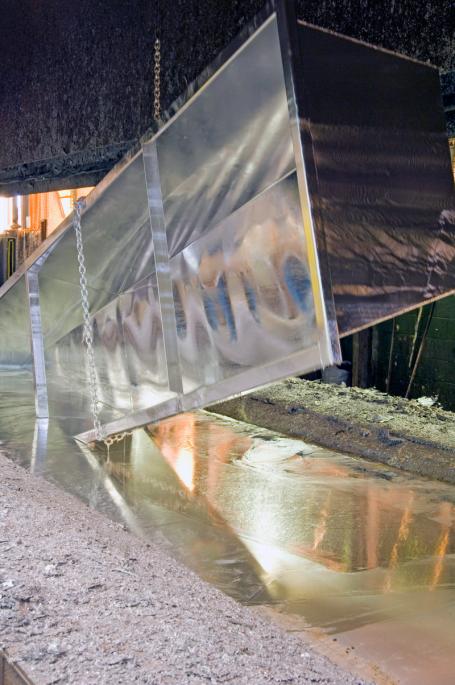Galvanising Process
Galvanising is the process of applying a coating of zinc to steel, in order to protect it against corrosion. The most common method used for the majority of sizes of steel members or fabrications is hot dip galvanising which involves the entire immersion of the steel product into a bath of molten zinc. For smaller and more intricate steel pieces, a centrifuge system that spins the steel components at a high speed is used at the stage of the hot dip to ensure an even coating of zinc, including across threads or hinges. Irrespective of the method is used, the result is a solid, strong, and durable coating that is bonded metallurgically to the steel, resulting in complete coverage and protection that is long lasting and prevents general corrosion.
The coating that results from galvanising is also self-sacrificial. The zinc serves as a sacrificial anode which means that if the coating is scratched, the steel is still protected by the zinc surrounding the scratch up to 3mm away. In contrast, other types of coatings tend to need regular renewal, particularly if they are ever physically breached.
In Australia all hot dip galvanising is performed to AS4680 and durability is calculated and specified using AS2312 part 2.
You can find in-depth details about each individual stage and more below:
Jump to
Surface Preparation
Acid Pickling
Hot Flux Treatment
The Hot Dip
Quenching
Fettling
Duplex Coatings
Process Video
Fabrication Design and Preparation
The AS4680:2006 Standard
The Resulting Levels of Protection
Other Technical Advice
Surface Preparation
Before the actual dipping takes place, there are a number of preparation stages done to the steel. Firstly, the fabrication to be galvanised is immersed in a hot caustic solution to remove any organic materials on the surface. This is followed by a rinse stage to remove the caustic before the next stage, acid pickling, takes place.
Acid Pickling
Acid pickling is used to remove oxides from the steel surface, and any caustic residue and is followed by another rinse.
Hot Flux Treatment
The last stage of chemical preparation for galvanising is a hot flux treatment, which prepares the steel fabrication by depositing a zinc ammonium chloride layer on its freshly cleaned surface.
The Hot Dip
The main stage is the hot dip, where the steel fabrication is completely immersed in molten zinc heated to 450°C, coating the entire surface, even recesses and returns that often cannot be coated using other means. The actual dip time is dependant on the steel thickness. During the immersion, zinc-iron alloy layers grow on the surface of the steel. The overall zinc coating mass that ends up on the steel depends on the mass and thickness of the steel product being galvanised. The AS4680:2006 standard for hot dip galvanising specifies the minimum coating thicknesses required to be applied to steel.
The Hot Dip Process is different during the Centrifuge Galvanising Process. Learn more about that here.
Zinc from galvanising ash can often be salvaged and reintroduced to the kettle though our MZR Machine.
Quenching
As soon as the fabrication is removed from the hot dip galvanising bath, it is immersed in a quenching solution which cools it, and also provides a chemical treatment to prevent any wet storage stain, also known as ‘white rust’ occurring on the galvanised surface.
Fettling
During fettling, Korvest Galvanisers carefully removes any uneven hardened galvanised drips to provide a smooth and quality finish to the surface of the final product.
All work is also manually inspected at this stage.
Duplex Coatings
Duplex coatings of galvanising-plus-paint are often the most economical solution to the problem of protecting steel in highly corrosive environments. Such systems provide a synergistic effect in which the life of the combined coatings exceeds the total life of the two coatings if they were used alone.
Process Video
Be sure to take a look at our Galvanising Process and other videos to watch in detail every step of the process and see how it works.
Fabrication Design and Preparation for Galvanising Handbook
You can learn more about how to properly design and prepare your steel fabrications for the galvanising process on our Preparation of Steel page. However, we have also compiled this information and more in a handbook you can download or ask us for a printed copy.
Feel free to review this information. We believe it will provide added value to your finished product.
The AS4680:2006 Standard
AS4680:2006 governs heavy duty after fabrication hot dip galvanising, meaning it is a standard that refers to the galvanisation of steel products that have already been fabricated.
As the coating is formed through the metallurgical reaction in the zinc kettle, the minimum coating thickness is always achieved with modern reactive steel chemistries tending to produce galvanised coatings in excess of the minimum requirement. Thicker steel sections produce thicker galvanised coatings but then thin material will receive an adequate coating of zinc.
The Resulting Levels of Protection
Barrier protection, cathodic protection and the zinc patina are what provide a galvanised coating its long-lasting protection.
When applied correctly, the galvanised coating physically provides complete coverage of all steel surfaces and acts as a tough barrier protecting the piece from the surrounding environment.
The coating also cathodically protects the steel from imperfections caused by accidental abrasion, cutting, drilling, or bending.
The zinc patina is insoluble and passive, which physically keeps the corrosion rate very slow. The zinc patina is a critical part of the coating’s longevity and actually forms with the aid of natural weather elements around it.
Other Technical Advice
We offer staff who are experts and can provide consultation in the design of fabrications to achieve the best corrosion protection result. On behalf of the GAA, we also offer current technical and data sheets through our Technical Advice page.
Learn more about the Mechanical Properties of Galvanising here.
We also recommend checking out the GAA's Frequently Asked Questions.

Steel emerging from the galvanising bath
